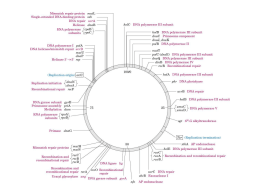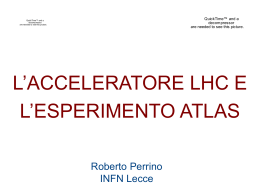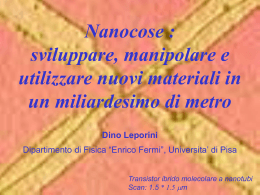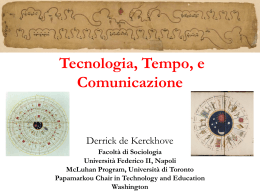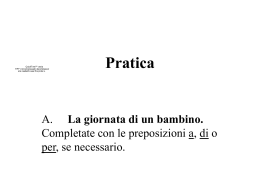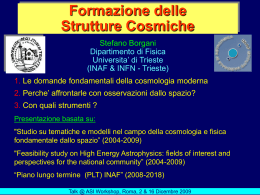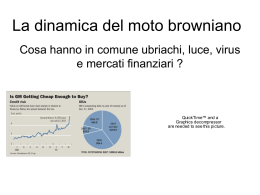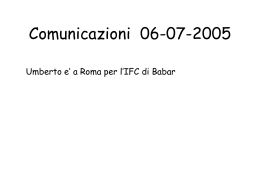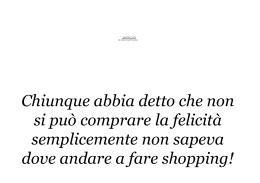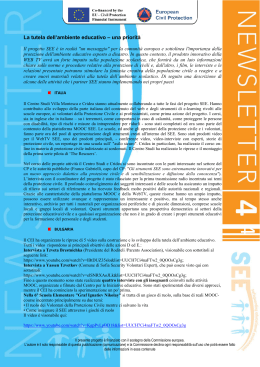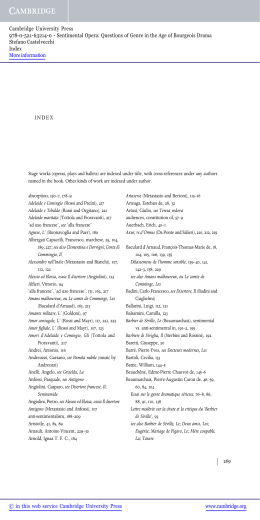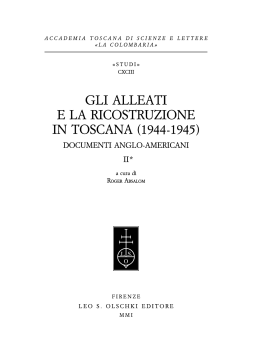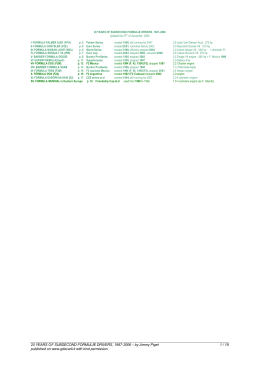Experiment/Experience "Interdisciplinary Postmodernism: Re-Thinking the Sixties" University College London, Saturday, 11th May 2013 Pierpaolo Antonello (Cambridge) [email protected] purification contamination 1900-1930: antipositivismo, idealismo, crocianesimo, mitografia, spiritualismo reazionario, occultismo 1930-1960: realismo, neo-realismo, razionalismo, neopositivismo, pragmatismo, internazionalizzazione, arte e industria 1960-1990: ideologismo, antiscentismo e antimaterialismo, adornismo, post-strutturalismo, ermeneutica, nihilismo 1990-2020(?): de-ideologizzazione e postmoderno critico, neorazionalismo critico, complessità, non-fiction novel, neo-neorealismo. P. Antonello, Contro il materialismo. Le ‘due culture’ in Italia: bilancio di un secolo (Torino: Aragno, 2012), p. xxv. K. Mannheim, The Problem of Generations (1923) B. Latour, Nous n’avons jamais été modernes. Essai d’anthropologie symétrique (Paris: La Découverte, 1994). “Collezione di studi religiosi, etnologici e psicologici” (Einaudi, 19481956; Boringhieri 1957-) Neo-rationalism, neo-positivism Nicola Abbagnano Enzo Paci Galvano Della Volpe Cesare Luporini Ludovico Geymonat Norberto Bobbio La tensione razionale Elio Vittorini Le due culture • Charles P. Snow, The Two Cultures and the Scientific Revolution. The Rede Lecture (Cambridge: Cambridge University Press, 1959); tr. it. Le due culture, prefazione di Ludovico Geymonat (Milano: Feltrinelli, 1964). • Ugo Spirito, Dal mito alla scienza (Firenze: Sansoni, 1966) • Giulio Preti, Retorica e Logica. Le due culture (Torino: Einaudi, 1968) • La cultura dimezzata, ed. Armando Vitelli (Milano: Giordano Editore, 1965). Strutturalismo • Umberto Eco, La struttura assente (Milano: Bompiani, 1967) • Massimo Cacciari and Francesco Del Co, ‘Lévi Strauss: strutturalismo e ideologia’, Angelus Novus, 9-10 (1966), pp. 53-101. • Cesare Segre, Du structuralisme à la sémiologie en Italie, in André Helbo (ed.), Le champ sémiologique (Bruxelles: Complexe, 1979), pp. L10. • Teresa De Lauretis, Semiotics in Italy, in Richard Bailey, Ladislav Matejka (eds.), The Sign. Semiotics around the world (Ann Arbor: Michigan University Press, 1980), pp. 248-257. «non solo il modello marxiano non è socialmente oggettivo ma non lo è neppure “scientificamente”: alla scientificità capitalistica, logica, socialmente comprensiva, Marx contrappone una scientificità “settaria”, che rappresenta oggettivamente una finalità rivoluzionaria, quindi “alogica” dal punto di vista del sistema»; Cacciari – Del Co, p. 88. Experiment Italo Calvino Primo Levi Cosmicomiche (1965) Ti con zero (1967) Il castello dei destini incrociati (1969 - 1973) Storie naturali (1966) Vizio di forma (1971) Il sistema periodico (1975) La chiave a stella (1978) Primo Levi, ‘Dello scrivere oscuro’ in L’altrui mestiere (Turin: Einaudi, 1985), pp. 49-55 experiment/experience experiment (n.) mid-14c., from Old French esperment "practical knowledge, cunning, enchantment; trial, proof, example, lesson," from Latin experimentum "a trial, test, proof, experiment," noun of action from experiri "to test, try" (see experience). experience (n.) late 14c., "observation as the source of knowledge; actual observation; an event which has affected one," from Old French esperience (13c.) "experiment, proof, experience," from Latin experientia "knowledge gained by repeated trials," from experientem (nominative experiens), present participle of experiri "to try, test," from ex- "out of" (see ex-) + peritus "experienced, tested," from PIE root *per- "to lead, pass over" (see peril). Meaning "state of having done something and gotten handy at it" is from late 15c. Gedankenexperimente, thought experiments M. Piattelli Palmarini (ed.), Livelli di realtà (Milano: Feltrinelli, 1984), p. 521. P. Fabbri, in B. Cottafavi — M. Magri (eds), Narratori dell’invisibile. Simposio in memoria di Italo Calvino. Sassuolo 21-23 febbraio 1986 (Modena: Mucchi, 1987), p. 27 M. Black, Models and Metaphors (Ithaca: Cornell University Press, 1962) M. B. Hesse, Models and analogies in science (London: Sheed & Ward, 1967) Thomas S. Kuhn, The Structure of Scientific Revolutions (Chicago: University of Chicago Press, 1962) “We would also like to consider that the Lager was pre-eminently a gigantic biological and social experiment” (If This is a Man, p. 93). “I would invite anyone who dares pass judgment to carry out upon himself, with sincerity, a conceptual experiment: Let him imagine, if he can, that he has lived for months or years in a ghetto… that, finally, he is loaded onto a train, eighty or a hundred persons to a boxcar; that he travels into the unknown, blindly, for sleepless days and nights; and that he is at last flung inside the walls of an indecipherable inferno” (The Drowned and the Saved, p. 59). “Vorrei invitare chiunque osi tentare un giudizio a compiere su se stesso, con sincerità, un esperimento concettuale: immagini, se può, di aver trascorso mesi o anni in un ghetto, tormentato dalla fame cronica, dalla fatica, dalla promiscuità e dall'umiliazione; di aver visto morire intorno a sé, ad uno ad uno, i propri cari; di essere tagliato fuori dal mondo, senza poter ricevere né trasmettere notizie; di essere infine caricato su un treno, ottanta o cento per vagone merci; di viaggiare verso l'ignoto, alla cieca, per giorni e notti insonni; e di trovarsi infine scagliato fra le mura di un inferno indecifrabile”. (OII 1036) “Thousands of individuals, differing in age, condition, origin, language, culture and customs, are enclosed within barbed wire: there they live a regular, controlled life which is identical for all and inadequate to all needs, and which is much more rigorous than any experimenter could have set up to establish what is essential could have set up to establish what is essential and what adventitious to the conduct of the human animal in the struggle for life”. (If this is a man, p. 87) “Si rinchiudano tra i fili spinati migliaia di individui diversi per età, condizione, origine, lingua, cultura e costumi e siano quivi sottoposti a un regime di vita costante, controllabile, identico per tutti e inferiore a tutti i bisogni: è quanto di più rigoroso uno sperimentatore avrebbe potuto istituire per stabilire cosa sia essenziale e che cosa acquisito nel comportamento dell’animaleuomo di fronte alla lotta per la vita”. (OI 83) Subject Experiment / Experience P. Levi, Il sistema periodico (Torino: Einaudi, 1975) R. Sennett, The Craftsman (New Haven-London: Yale UP, 2008) Tarocchi. Il mazzo visconteo di Bergamo e New York (Parma: Franco Maria Ricci, 1969) I. Calvino, Il castello dei destini incrociati (Torino: Einaudi, 1973) ‘it titillated our moderate taste for the heroic period of the industrial revolution […]; it did not wish to innovate at all cost. The first discussions were about classic texts seen as our antecedents’. ‘The Littérature potentielle is an apology of the homo faber’. J. Lescure, ‘Piccola storia dell’oplepo’, in R. Campagnoli Y. Hersant (eds), Oulipo. La letteratura potenziale (Creazioni Ricreazioni Ricreazioni) (Bologna: CLUEB, 1986), pp. 30-31. “I remain basically an artisan, I like to make constructions which hold well [...] I’m an artisan in a epoch in which the avantgarde does a bit of everything; and even though our fields don’t overlap, they influence each other”. “io resto uno scrittore di impianto artigiano, mi piace fare delle costruzioni che chiudono bene […] io faccio lartigiano ma in unepoca in cui lavanguardia fa questo e questaltro; e i campi anche se non si toccano si influenzano” I. Calvino, Lettere 1940-1985, ed. by L. Baranelli (Milano: Mondadori, 2000), p. 1003. Anna Botta, “Calvino and the Oulipo: An Italian Ghost in the Combinatory Machine?”, MLN, 112.1 (1997), 81-89 Art/Play Johan Huizinga, Homo Ludens (1939 – 1946) Rogers Callois, Les Jeux et les hommes (1958) C. Levi-Strauss, La Pensée sauvage (Paris: Plon, 1962) Elliott M. Avedon, Brian Sutton-Smith, The Study of Games (Wiley, 1971) “the experimental method emerged at the same time that the theory of large numbers, of chance and games”. M. Serres, Le système de Leibniz et ses modèles mathématiques (Paris: PUF, 1968)., p. 173. Arte come mestiere (1966) Design e comunicazione visiva (1968) Artista e designer (1971) Codice ovvio (1971) We ought to demolish the myth of the artist as a star, who only makes masterpieces for intelligent people [...] It is necessary that the artist abandons any romantic aspects to become an active man among other men. Someone who is informed on present technologies, materials and working methods. Someone who, without abandoning his instinctive aesthetic sensitivity, would respond with humbleness and competence to the questions that his fellow human beings will ask him. Si rende oggi necessaria un’opera di demolizione del mito dell’artista-divo che produce solo capolavori per le persone intelligenti. […] è necessario che l’artista abbandoni ogni aspetto romantico e diventi un uomo attivo fra gli altri uomini, informato sulle tecniche attuali, sui materiali e sui metodi di lavoro e, senza abbandonare il suo innato senso estetico, risponda con umiltà e competenza alle domande che il prossimo gli può rivolgere. (B. Munari, Arte come mestiere: 19) QuickTi me™ and a decompressor are needed to see this picture. QuickT ime™ and a decompressor are needed t o see this picture. QuickTime™ and a decompressor are needed to see this picture. QuickTime™ and a decompressor are needed to see this picture. QuickTime™ and a decompressor are needed to see this picture. QuickT ime™ and a decompressor are needed to see this picture. QuickTime™ and a decompressor are needed to see this picture. Alberto Munari, ‘How could it be done differently?’, in Bruno Munari: My Futurist Past, eds. M. Hajek, L. Zaffarano (Milano: Silvana, 2012), pp. 165-68.
Scarica
